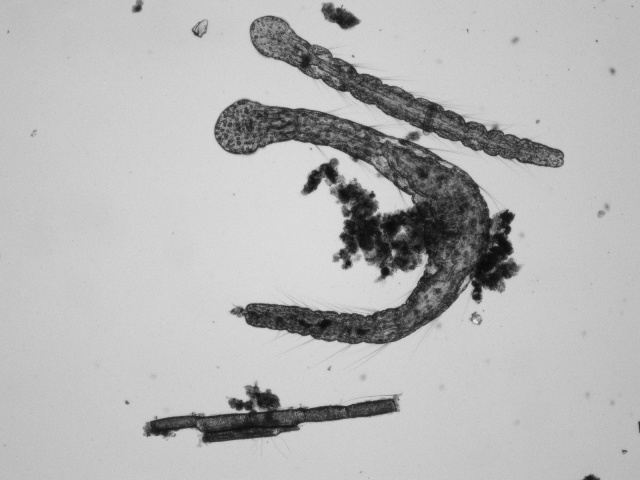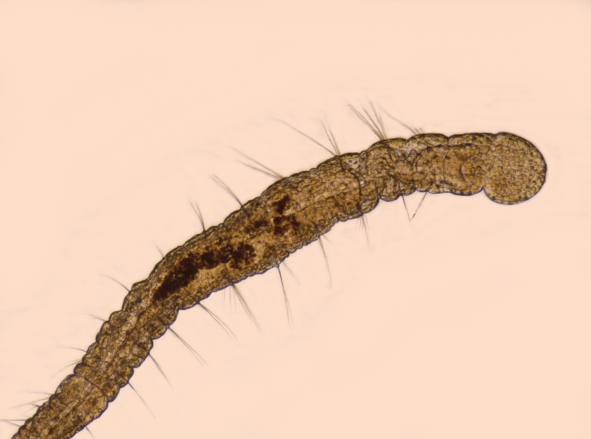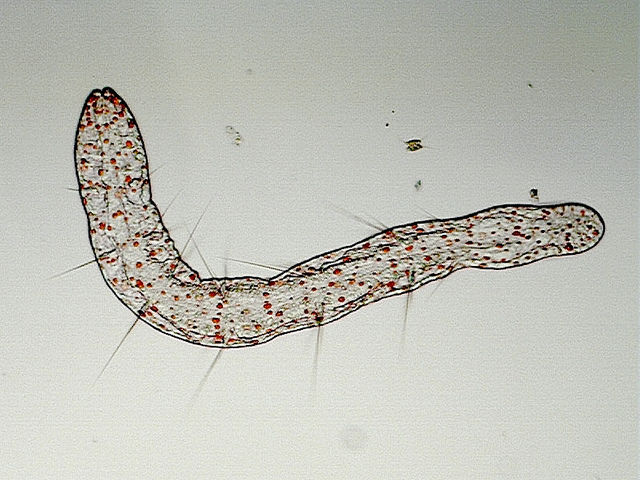Phylum Annelida
Class Polychaeta
Family Aeolosomatidae
Common names: freshwater polychaetes, suction-feeding worms
Overview
Aeolosomatidae are minute, oligochaete-like worms that mostly inhabit freshwater. They lack head appendages and parapodial lobes (paired unjointed lateral body outgrowths characteristic of polychates). The body of aeolosomatids is often brightly coloured due the presence of coloured epidermal glands. Each gland cell, the function of which is unknown, consists of a vacuole, filled with red, green, blue-green, yellow, or sometimes colourless liquid. The lobate prostomium (first body segment) possesses numerous cilia both ventrally and in a conspicuous groove posterior to the prostomium. Constrictions along the trunk give the appearance of external segmentation, but they actually represent a chain of zooids produced by paratomy (fragmentation). Setae (hairs) are usually present as four bundles per segment and may be smooth and slender (capillaries) or sigmoid (s-shaped) hooks. Aeolosomatids are very small and thin, ranging from 0.3-10 mm in length and 0.04-0.06 mm in diameter.
Distribution and diversity
There are around 30 described species of Aeolosomatidae from three genera (Aeolosoma, Rheomorpha and Histricosoma). There have been two species from a single genus described from Australasia. Although there are no published records of aeolosomatids from Australia, many undescribed species are known to occur throughout the continent and more are likely to be discovered as interstitial fauna is sampled in previously unstudied freshwater habitats. The Aeolosomatidae had been considered to be members of the Clitellata but are currently placed as provisional Polychaeta incertae sedis. However, further work may yet result in the Aeolosomatidae being moved back to the Clitellata.
Life cycle
Aeolosomatidae are hermaphrodites, however sexually reproduction only occurs rarely or sporadically. Most reproduction is asexual by paratomy/fission (fragmantation) as posterior segments break away or detach from the parent worm. It begins when the worm reaches a determined number of metameres (depending on the species), which gives rise to the clonal production of a chain of filial zooids that detach themselves from the parental zooid in a few days. This leads rapidly to high population densities. Some species can form desiccation-resistant cysts that allow them to survive adverse conditions and to be more easily transported between water bodies by animals.
Feeding
Aeolosomatidae have the common name of �suction-feeding worms� and feed by placing their prostomium (first body segment) over the substrate creating a vacuum. They consume the algae attached to the sediment particles they ingest.
Ecology
Aeolosomatidae predominantly occur in lakes, rivers and other freshwater bodies, but a few are found in brackish/estuarine habitats and one marine species has been reported. They are bottom and sediment dwellers, inhabiting spaces amongst aquatic plants and the detritus-rich sands and sediments of freshwater habitats (interstitial fauna). Aeolosomatids are beneficial in the breakdown of organic materials and nutrient cycling and are also important in many aquatic food webs being preyed upon by other aquatic invertebrates, amphibians and fish. Like many aquatic invertebrates, changes in the assemblage composition and species abundances of aeolosomatids have proven useful as biological indicators of organic pollution in freshwater systems.

Aeolosomatidae from Israel
Image credit: � Ariel Chipman
used with permission

Aeolosomatidae
Image credit: � Western Australian Museum
Photographer: Erich S. Volschenk









